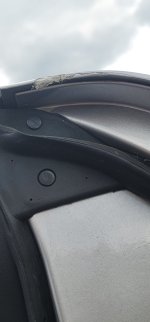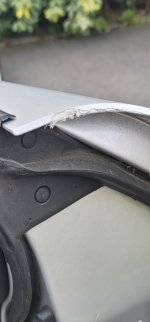You are using an out of date browser. It may not display this or other websites correctly.
You should upgrade or use an alternative browser.
You should upgrade or use an alternative browser.
Fibre glass repair
- Thread starter Nickeh
- Start date
Stingray
CCCUK Member
Sellotape (to protect the undamaged area)
Araldite (will soak in nicely to those torn fibres)
Sellotape (to stick over the araldite and keep it flat, in the right place)
Emery cloth (to sand things smooth, once Araldite fully cured)
Touch-up paint.
Do it carefully and no one will ever notice.
Araldite (will soak in nicely to those torn fibres)
Sellotape (to stick over the araldite and keep it flat, in the right place)
Emery cloth (to sand things smooth, once Araldite fully cured)
Touch-up paint.
Do it carefully and no one will ever notice.
Custom exotics
Well-known user
Do not use araldite if your going to do repair do it properly that will need grinding back and fibre glass mat repair to put strength back in it and deal with the spider cracks you tend to find you get a week or so after damage. We are currently not in a position to offer our services as we are currently in the process of setting up our new bodyshop !
Mr. Cricket
Committee Member
The outer skin isn't fibreglass, it's plastic. Looks to me and I'm no body man that a small Dremel to get it smoothed out then just build up with a good filler.

 www.motortrend.com
www.motortrend.com

C5 Corvette Body Repair - How To Fix '97-'04 Corvette Body Damage - Vette Magazine
We use our 1997 Chevrolet Corvette to show you how to repair the sheet-molded compound (SMC) body panels and bumper-mounting tabs on your C5 Corvette - Vette Magazine
Custom exotics
Well-known user
Don't give out advice if you do not know what your talking about outer skin of c5 doors is fibre glass !!!!The outer skin isn't fibreglass, it's plastic. Looks to me and I'm no body man that a small Dremel to get it smoothed out then just build up with a good filler.

C5 Corvette Body Repair - How To Fix '97-'04 Corvette Body Damage - Vette Magazine
We use our 1997 Chevrolet Corvette to show you how to repair the sheet-molded compound (SMC) body panels and bumper-mounting tabs on your C5 Corvette - Vette Magazinewww.motortrend.com
Mr. Cricket
Committee Member
Don't give out advice if you do not know what your talking about outer skin of c5 doors is fibre glass !!!!
You seem to be quite sure about that assuming Custom Exotics is what you do I'll agree that you know more in this field than I ever will..
But. It would seem that plastic is used in C5 (and later models) reducing the fibreglass content to just 20% chopped filler:
C5: Getting Serious About Weight Savings
The introduction of the C5 in 1997 represented one of the rare instances in the automotive world where the next-generation model weighed less than its predecessor. Even more impressive, the '97 Corvette was larger overall--longer and wider--than the '96 model, yet it tipped the scale at about 3,220 pounds with a manual transmission, compared with the '96's 3,300-pound curb weight.A number of contributors helped drive down the C5's weight, including the use of SMC body panels that had a higher content of plastic than ever before. The material, which is basically the same as used in the C6, was composed of about 40 percent resin--polyester, vinyl ester, styrene, or a blend of all three--33 percent calcium-carbonate filler, 20 percent chopped fiberglass, and the remaining 7 percent resins and hardeners that improve the out-of-mold surface finish.
Source: Corvette Body Materials - - Vette Magazine
The 20% chopped fibreglass is just filler to stiffen the panel. I had two C5's back in the day and in no way is the outer surface the same as my current C2's & C3 which are of course fibreglass..
Custom exotics
Well-known user
Front fenders and front and rear bumpers are the only bodywork that are plastic on a c5 ,doors quarters bonnet sills are all vaccum bagged fibreglassYou seem to be quite sure about that assuming Custom Exotics is what you do I'll agree that you know more in this field than I ever will..
But. It would seem that plastic is used in C5 (and later models) reducing the fibreglass content to just 20% chopped filler:
C5: Getting Serious About Weight Savings
The introduction of the C5 in 1997 represented one of the rare instances in the automotive world where the next-generation model weighed less than its predecessor. Even more impressive, the '97 Corvette was larger overall--longer and wider--than the '96 model, yet it tipped the scale at about 3,220 pounds with a manual transmission, compared with the '96's 3,300-pound curb weight.
A number of contributors helped drive down the C5's weight, including the use of SMC body panels that had a higher content of plastic than ever before. The material, which is basically the same as used in the C6, was composed of about 40 percent resin--polyester, vinyl ester, styrene, or a blend of all three--33 percent calcium-carbonate filler, 20 percent chopped fiberglass, and the remaining 7 percent resins and hardeners that improve the out-of-mold surface finish.
Source: Corvette Body Materials - - Vette Magazine
The 20% chopped fibreglass is just filler to stiffen the panel. I had two C5's back in the day and in no way is the outer surface the same as my current C2's & C3 which are of course fibreglass..
Custom exotics
Well-known user
Repaired loads of these we own 2 c5 and a c6 I think we should know how to repair themThe C5 as Mr Cricket says isn’t fibreglass…
The C5 is sheet moulded composite, it may look like fibreglass as it does have reinforcing fibres. Fibreglass won’t adhere to the SMC…
Mr. Cricket
Committee Member
Is the outer skin on a C5 fiberglass?Repaired loads of these we own 2 c5 and a c6 I think we should know how to repair them
Custom exotics
Well-known user
Yes you would do a normal fibreglass repair please feel free to give scott a call on 07915387879 and he will give you the best advice possible to effect a repair
Mr. Cricket
Committee Member
So no then. We could have avoided all this if you'd just agreed it's not fibreglass and mostly plasticYes you would do a normal fibreglass repair please feel free to give scott a call on 07915387879 and he will give you the best advice possible to effect a repair
teamzr1
Supporting vendor
Re-read what the write-up of that URL aboveRepaired loads of these we own 2 c5 and a c6 I think we should know how to repair them
Quote
"
The Introduction of SMC
Starting with the C3 generation in 1968, body parts were manufactured with a press-mold process, whereby the fiberglass material and resin were shaped in a die-like tool that produced smoother parts more quickly.It was a significant jump in forming technology and laid the groundwork for a change in the body panels' material in 1973.
That year, the composition changed from conventional fiberglass to sheet-molded compound (SMC), which was composed of fiberglass, resin, and a catalyst formed under high heat and pressure.
The ratio of resin to fiberglass was reduced with SMC, while the fiberglass itself was a bit coarser.
The new material helped produce panels that were even smoother right out of the mold, meaning they required less surface finishing prior to painting. It also helped create a better final paint finish.
Technically, all Corvettes since 1973 have used SMC body panels, but the material composition has changed dramatically, featuring less traditional fiberglass and more lightweight plastic.
The early SMC material created parts that were stronger and more rigid, but more brittle. As SMC technology and production experience evolved, Corvette engineers were able to alter the material composition and the body parts' specifications in order to trim the car's curb weight--an endeavor that was certainly welcomed though the later C3 years, as engine output kept eroding.
Mostly, that meant making thinner body panels, because SMC was denser and stronger than conventional fiberglass.
The assembly-plant changeover from St. Louis to Bowling Green in 1981 brought a switch to a more plastic-infused formula for the SMC body panels.
Custom exotics
Well-known user
Its not bloody pastic do you know what stick ur Araldite on it better still buy yourself some pickstick and use that I am through trying to give advice to peopleSo no then. We could have avoided all this if you'd just agreed it's not fibreglass and mostly plasticAll good and hopefully Nick gets his Corvette sorted
Custom exotics
Well-known user
No metal or fibreglass or plastics require different primerSo a question would be
IF doing the repair with only pre-1981 fiberglass makeup,
does not than to assure paint matches and the difference in SMC and just fiberglass surfaces
require different primer ?
teamzr1
Supporting vendor
Front fenders and front and rear bumpers are the only bodywork that are plastic on a c5 ,doors quarters bonnet sills are all vaccum bagged fibreglass
Starting with C4s,
do not have external bumpers, but instead urethane fascia that are not per se plastic
Urethane fall into the category of materials called rubber.
But they're not quite rubber, either. Urethane fill the gap between rubber and plastic.
They're harder than rubber, which contributes to their outstanding load-bearing abilities.
So another surface type and requires different primer and paint shade the body has.
Custom exotics
Well-known user
Mate you are talking rubbish do you actually think the manufacturer changes the shade of paint to do the bumpers !!!!! Please !!! I have never heard do much rubbish in all my life!Starting with C4s,
do not have external bumpers, but instead urethane fascia that are not per se plastic
Urethane fall into the category of materials called rubber.
But they're not quite rubber, either. Urethane fill the gap between rubber and plastic.
They're harder than rubber, which contributes to their outstanding load-bearing abilities.
So another surface type and requires different primer and paint shade the body has.


